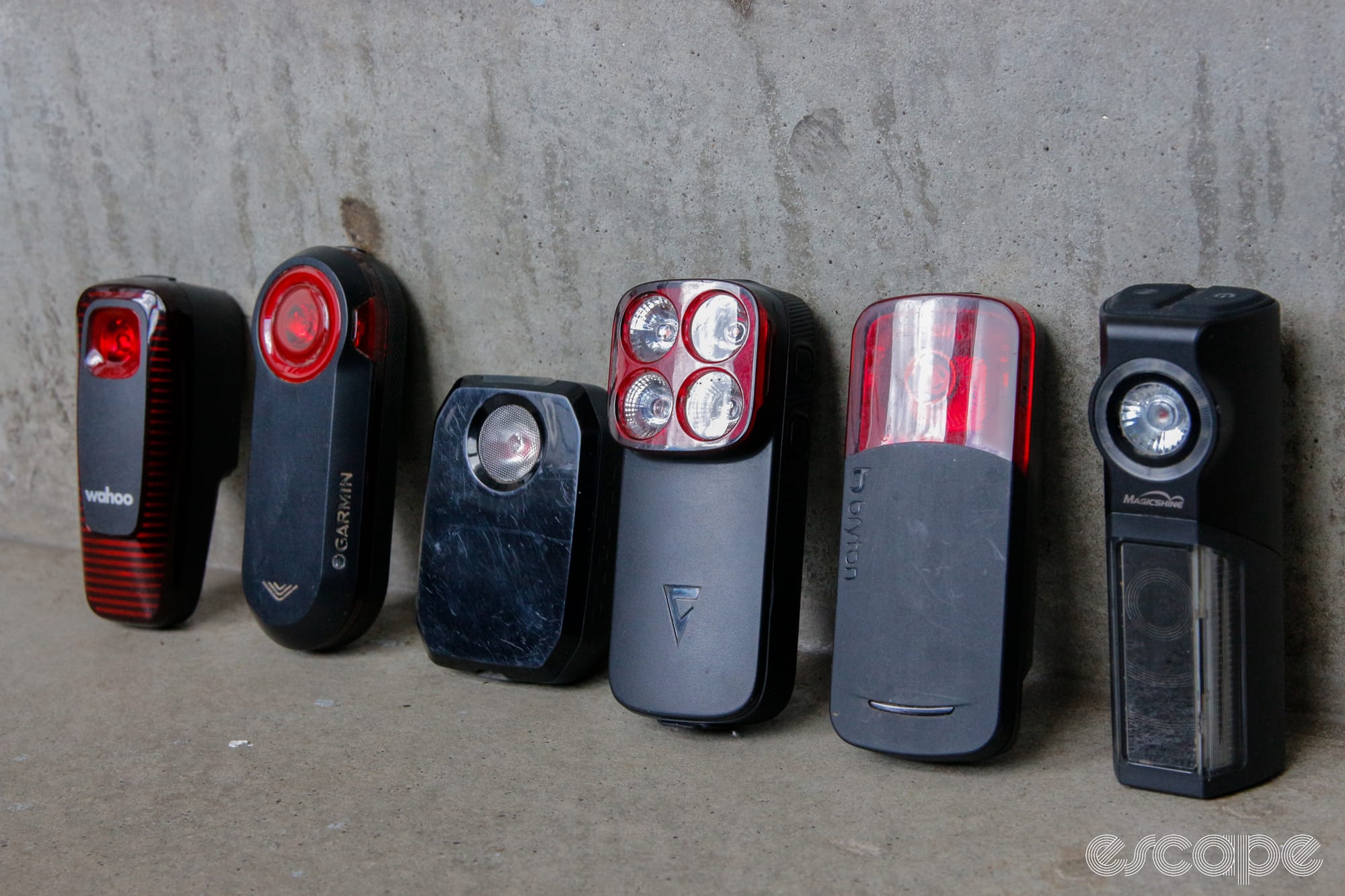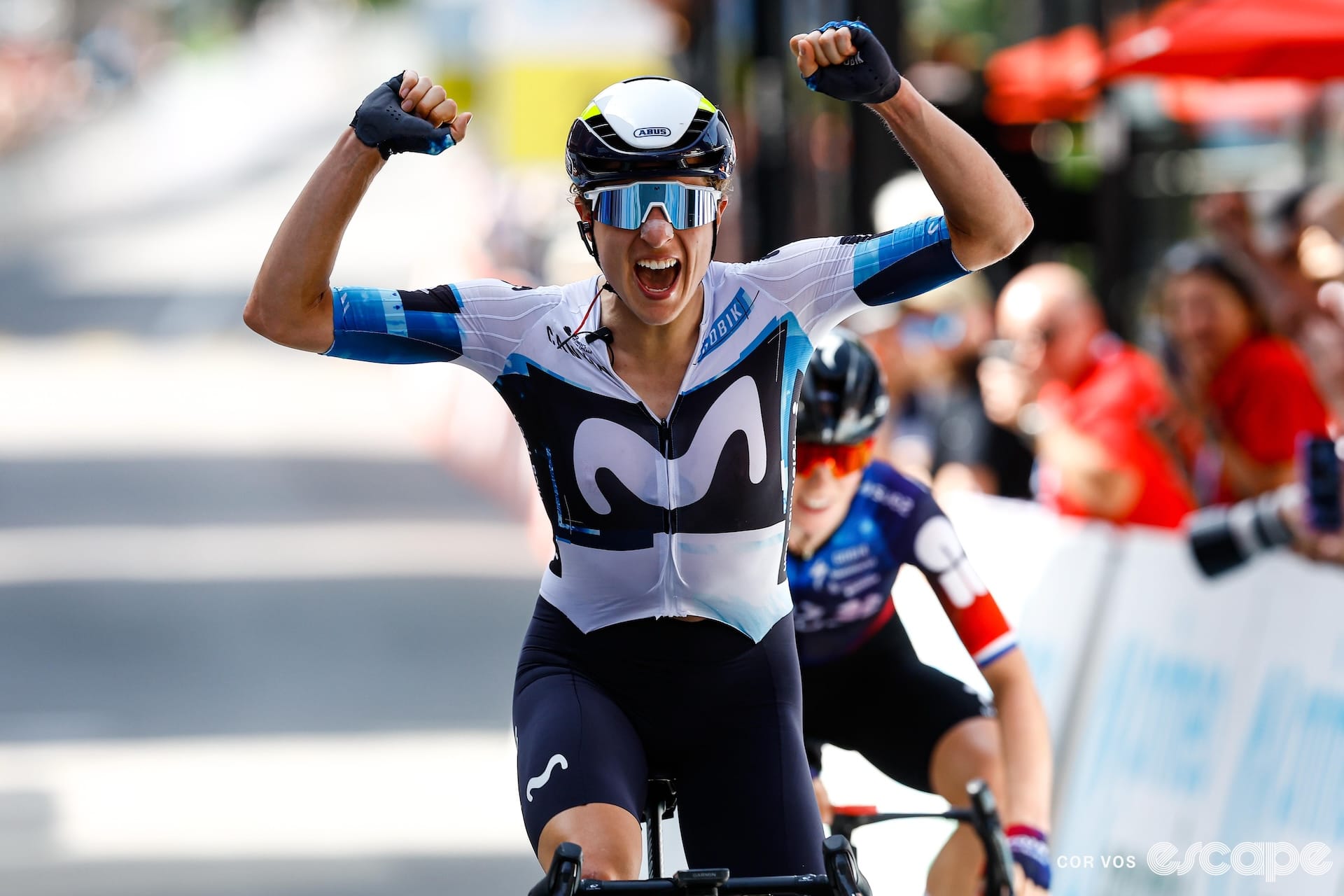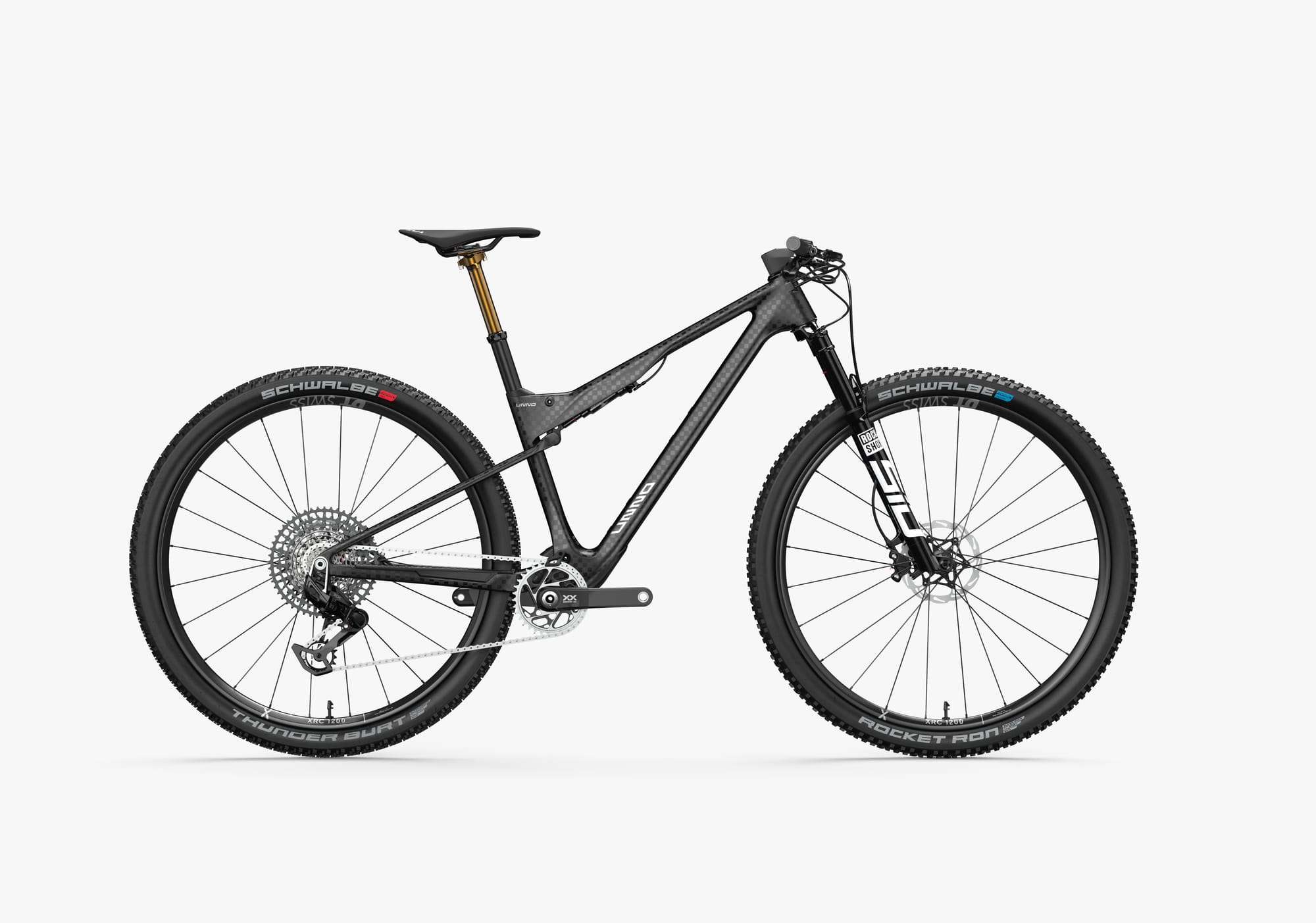Following months of rumour, weeks of speculation, and almost a week of full public display at the Tour de France, Continental, SwissSide and DT Swiss has finally officially unveiled their much-anticipated aero road tyre. Yes, this is a new tyre from three different brands, with each bringing their own expertise and input to the development and so, unsurprisingly, each now wants a chunk of the credit.
The result of that three-way development program is a rather unique-looking tyre, unlike anything in Continental’s current range of premium road tyres, with offset cutouts or scallops or cavities: call them what you will, the trident of brands call them vortex generators, dotted all the way around the tread cap, and multiple brand logos dotted around the sidewall.
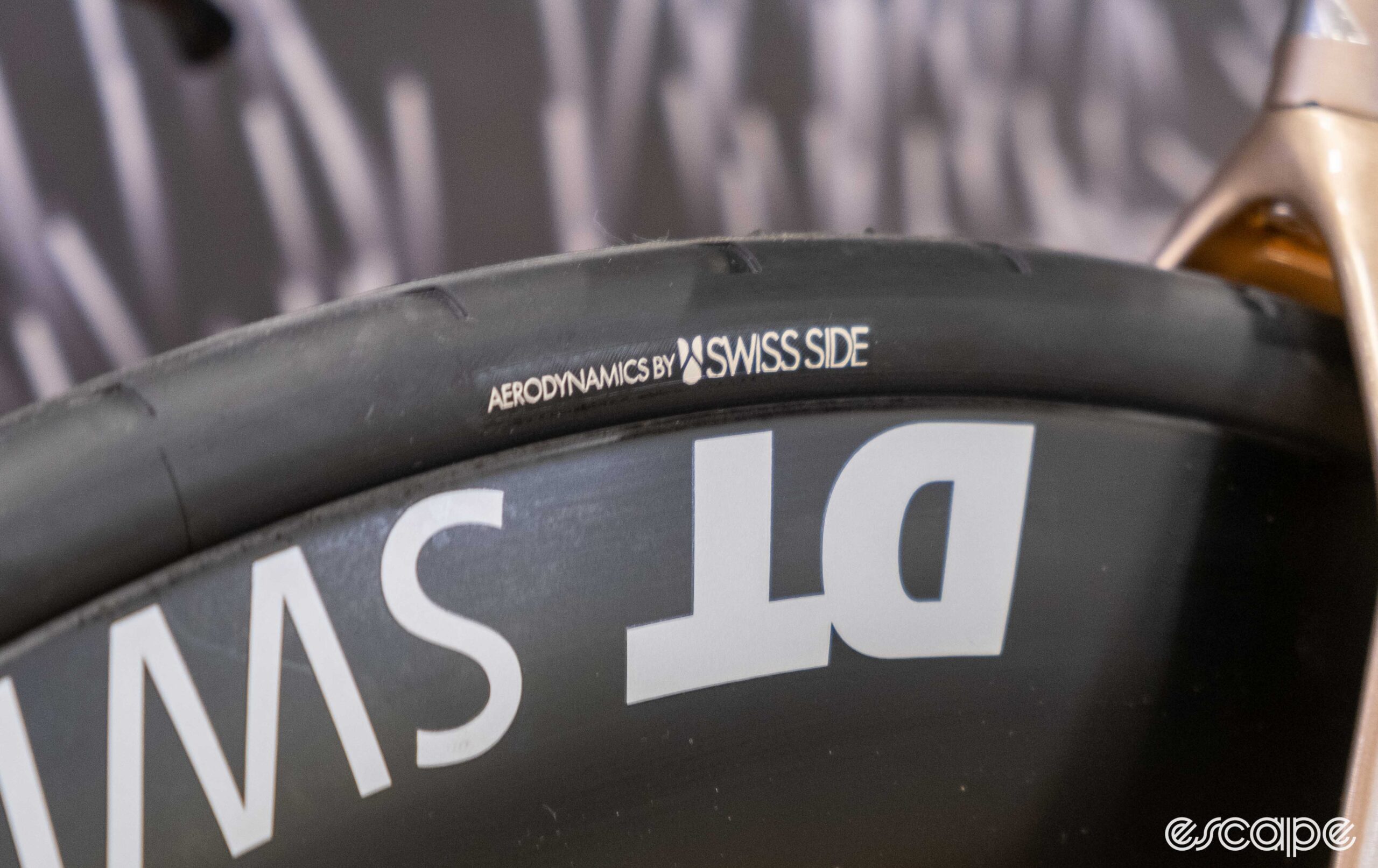
It’s not exactly a beautiful-looking tyre, but that’s not the point. Unlike traditional good-looking and sometimes fast-rolling classic tan-sidewall tyres or even the existing regular-looking Conti GP 5000 S TR, the new tyre, officially named the Aero 111, is designed with a single function in mind: improved aerodynamics balanced with low rolling resistance, all in the name of going faster.
Pull the other one
Ok, I can hear you:“Aero tyres … come on,” and you might have a point, but the 111 is not aero in that it features a teardropped shape, peaked tread, or is aero profiled in some other way. In fact, the 111 is not shaped any differently to a regular tyre. Instead, its aero-enhancing properties come from the 48 vortex-generating cutouts that line both sides of the tread.
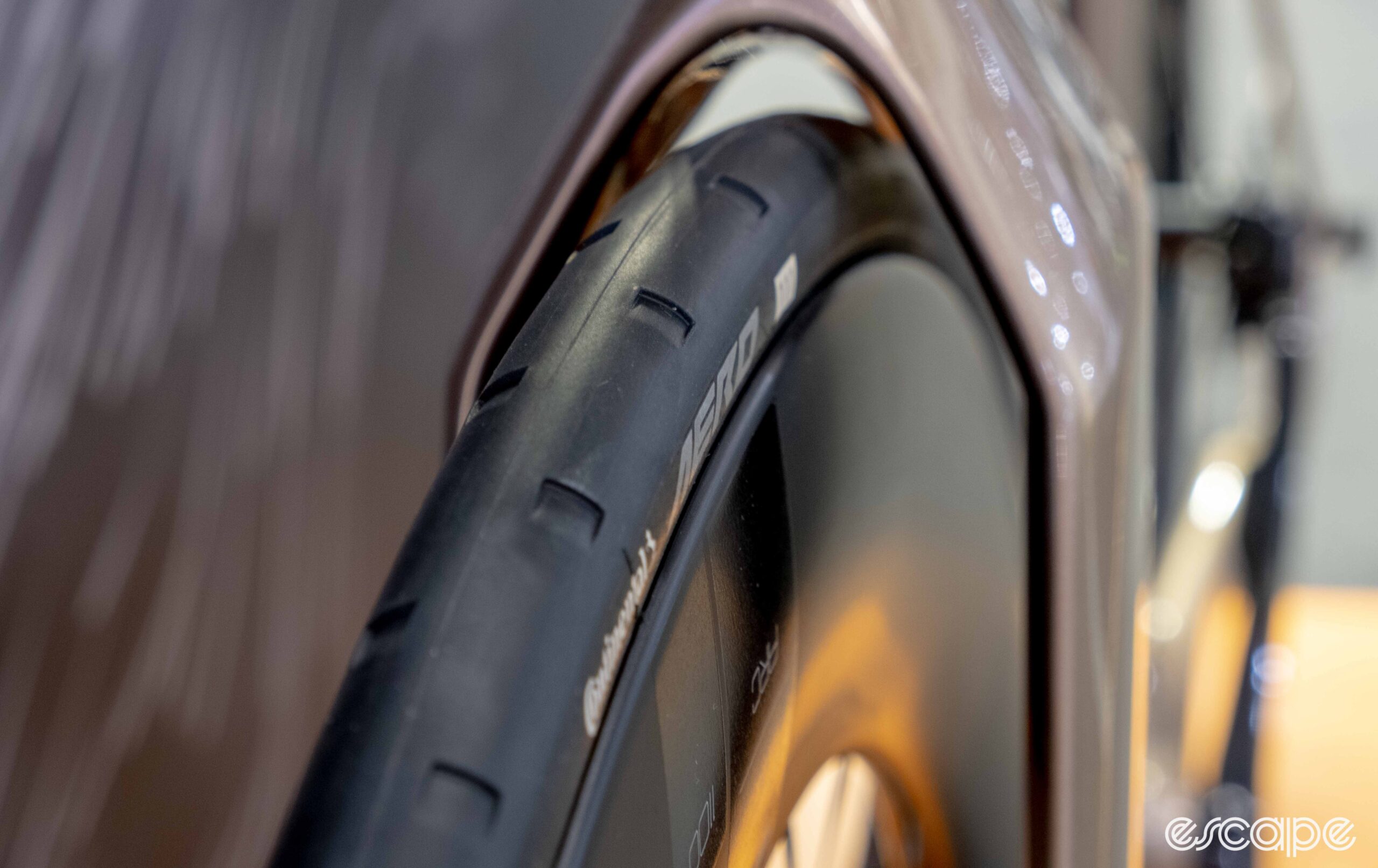
The cutout tread pattern creates turbulent airflow over the tyre as it rotates, and this induced turbulence is said to aid the flow in sticking to the wheel rim profile. Conti, DT and SwissSide all claim the result of this is a drag reduction for the front wheel system, better utilisation of the “sail effect,” and even a more stable front wheel, less susceptible to crosswinds and blustery conditions. Furthermore, the trident claims the design provides an aero benefit regardless of rim design or speed.
That’s a lot of action for a simple tyre cutout and suddenly sheds light on SwissSide CEO JP Ballard’s comments regarding the Rule of 105 and tripping airflow at the tyre on the Performance Process podcast earlier this year.
As for the rest of the tyre, it’s very similar to the existing GP 5000 S TR in both claimed rolling resistance (the 111 is said to offer a little lower coefficient of rolling resistance [CRR] but more than the GP5000 TT TR) and other features. The rubber is the same BlackChili compound used in the existing performance tyres. The new tyre also gets the Continental Vectran breaker puncture-protecting strip, and it is approved for use in clincher, tubeless, and tubeless straight side (hookless) setups.
The new tyre is available in 26 or 29 mm widths, and is front-wheel specific, meaning it’s fine to pair it with a different rear tyre, and is priced at a whopping US$120/€120. In other words, the aero gains are only available on the front wheel, so buy a regular rear tyre focused on reduced rolling resistance.
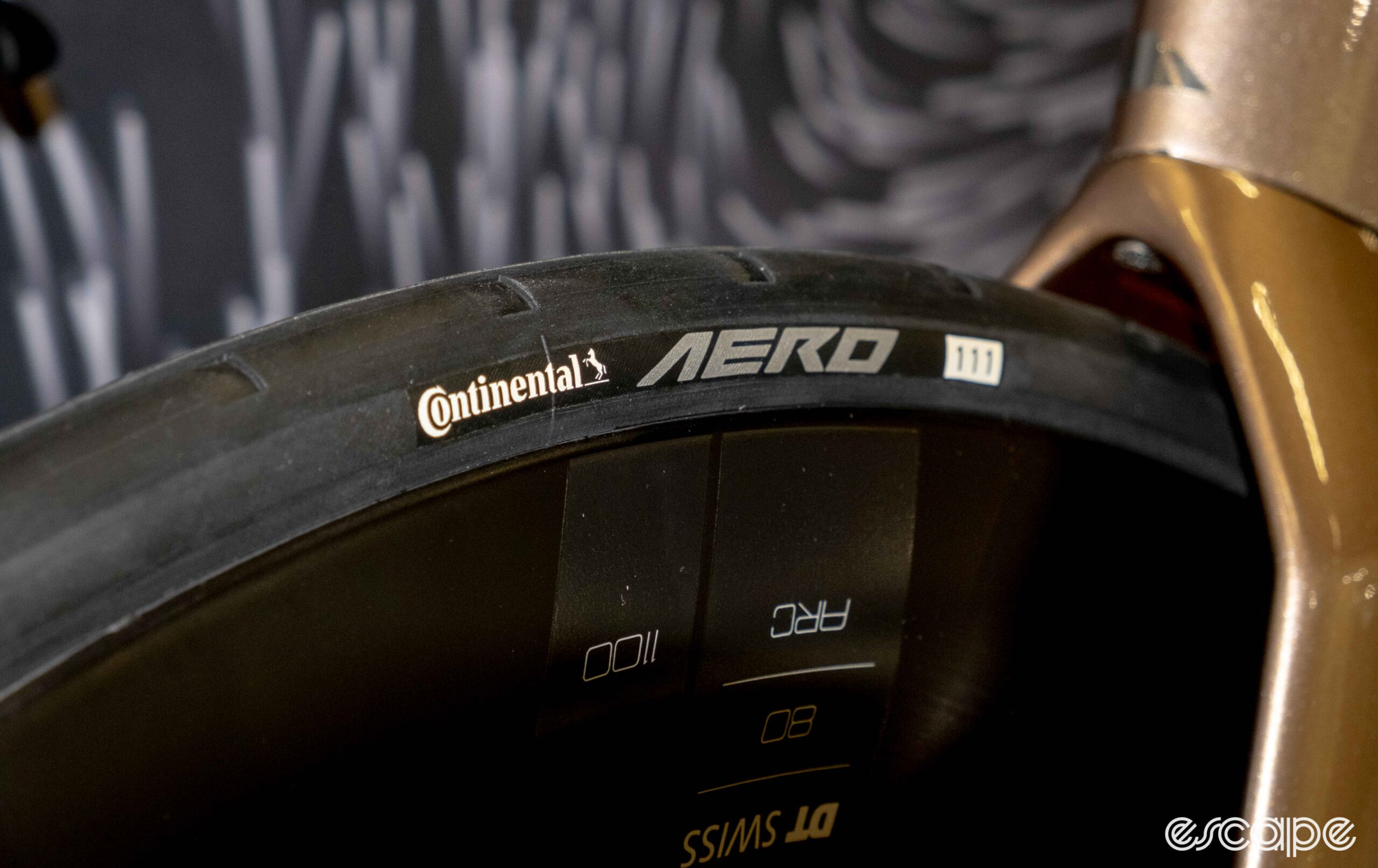
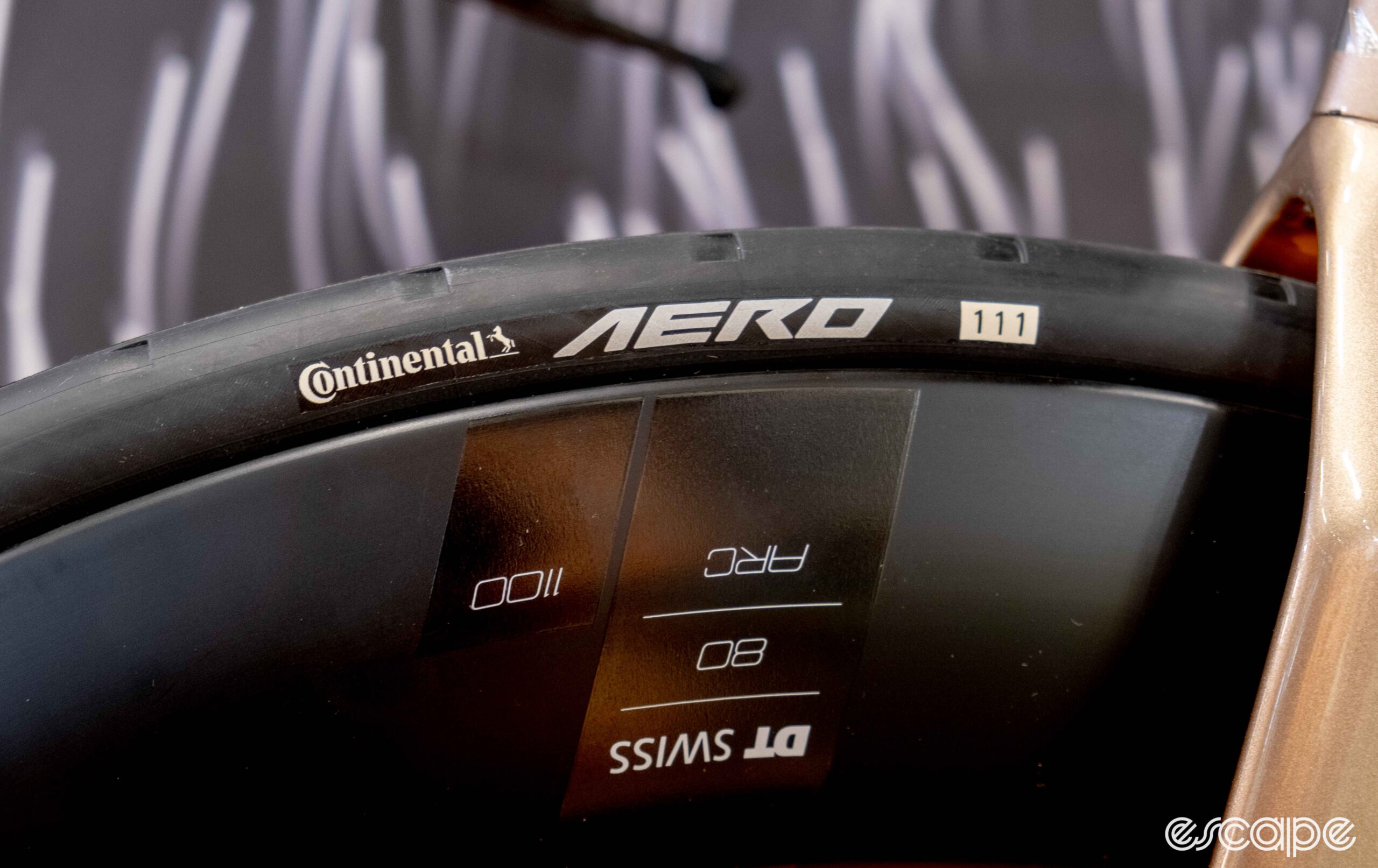
WT… S
So how did this all come about. According to the press materials circulated by the brands involved, the project began with DT Swiss, who, having already engaged SwissSide in the development of its aero wheelsets, wanted to develop a tyre to optimise the entire Wheel Tyre System (WTS).
The pair quickly established a tyre design but needed a “rubber expert” to bring it to reality in a tyre combining the advancements already made in rolling resistance and grip. That's where Continental came on, and the result is the Aero 111 tyre. The three brands are describe it as a turning point for wheel system development and boldly claim it will be impossible to develop tyre or rim independently ever again.
At the heart of the aero claims are the 48 offset cutouts dotted all the way around the tread. These cutouts create vortices as they rotate at speed with the tyre, effectively inducing turbulence and controlling and sticking the airflow around the sidewall and onto the rim.
As wild as that sounds, it’s not exactly a new phenomenon, but is rather pretty well understood in aerodynamics.
But does it work? Typically, cyclists do not achieve speeds high enough to truly benefit from flow control, vortex generators, or induced drag. The 111 tyre is different, though, because not only are the aerodynamics of a fast-rotating tyre very different from those of a passive frame, helmet, or clothing aero, but with so many cutouts on that rotating tread, it makes sense they may combine to provide a more potent effect.
It’s important to state I am not an aerodynamicist and haven’t tested the new tyres yet, but that’s at least how it works in my head.
As you might expect, though, Conti, DT and SwissSide have tested the new tyre and have some lofty claims on its aero potency. The brands showed graphs suggesting similar drag numbers when comparing the 26 mm Aero 111 and the narrower 25 mm GP 5000s TR. The data comparisons use a speed of 30 km/h and measure between +/-5° of yaw, with the tire installed on DT Swiss' ARC 1100 Dicut DB 62 wheelset. But beyond that +5° yaw angle, the Aero 111-equipped wheel demonstrated a significant drag reduction, and an even greater benefit below -5/-10°.

We weren’t provided with actual numbers and so we have to decipher as best we can from the graphs what the actual power savings are. At higher speed (45 kph), both tyre options remained much closer and more consistent from roughly -12° to +12° of yaw, albeit with the Aero 111 marginally faster. Beyond that range, from -15 and +15 outward, the red line representing Aero 111 drag continues to drop, presumably as the wheel picks up the so-called sail effect, meanwhile the the flow has stalled over the GP 5000s TR-wrapped rim and so drag is on the up. The result, according to these graphs, is a frankly astonishing 10-15 watts at the outer ranges of the yaw sweep... really?
There is one common theme across all the testing: The Aero 111 is either marginally faster or mostly seemingly a wash with other tyres at lower yaw angles. The lower yaw angles – where typically anyone overly concerned about aerodynamics tends to operate given increasing racing speeds – will reduce the effective yaw angle. So how representative are those higher yaw angle conditions where the Aero 111 looks considerably faster, given they are typically occur only either 1) when a rider is experiencing significant crosswind conditions or 2) speed is much lower?
In such scenarios aero might not be the main concern, but the trident claim otherwise. We often think as aero as going faster, but aero also relates to handling characteristics in blustery conditions. An aerodynamically poor setup that stalls at higher yaw angles will see the rider experience more unpredictable and less-controllable steering as the front wheel is battered and buffetted about. We’ve all had that moment where a gust catches the front wheel. Continental claims the 111 Aero's characteristics means it makes for more predictable steering with fewer sudden jolts.
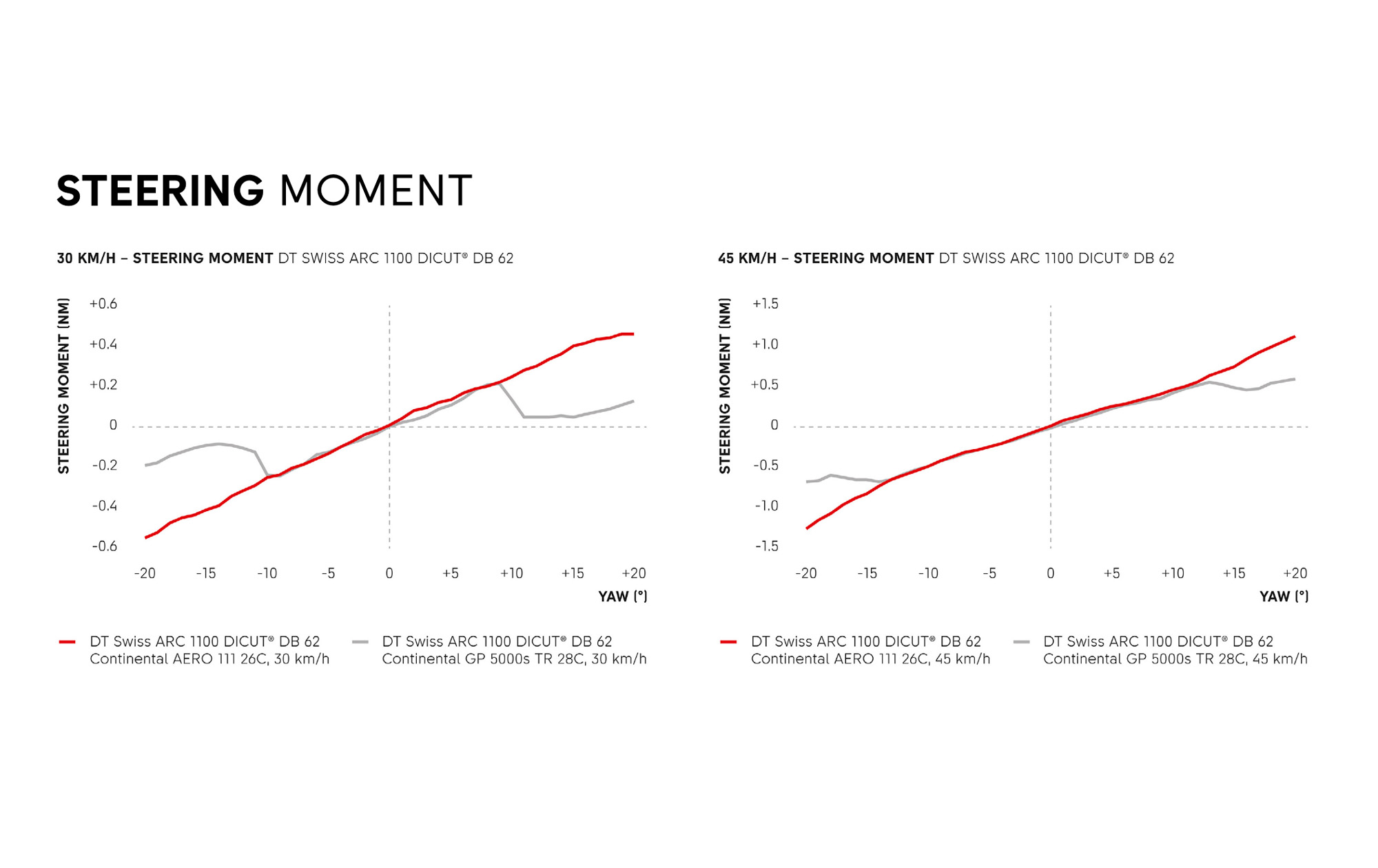
The brands had wind tunnel data to demonstrate this also, with a steering moment test setup to measure the torque exerted on the front wheel across a yaw sweep. Again, the brands showed results seemingly demonstrating the 111 performed better at 30 and 45 km/h than the GP 5000s TR, which demonstrated a sudden jolt-like blip at around +/-10° at the lower speed and +/-15° at the higher speed.
There was also testing which seems to indcate the wider 29 mm tyres have a similar performance benefit on shallower rims and the lower 30 km/h speed.
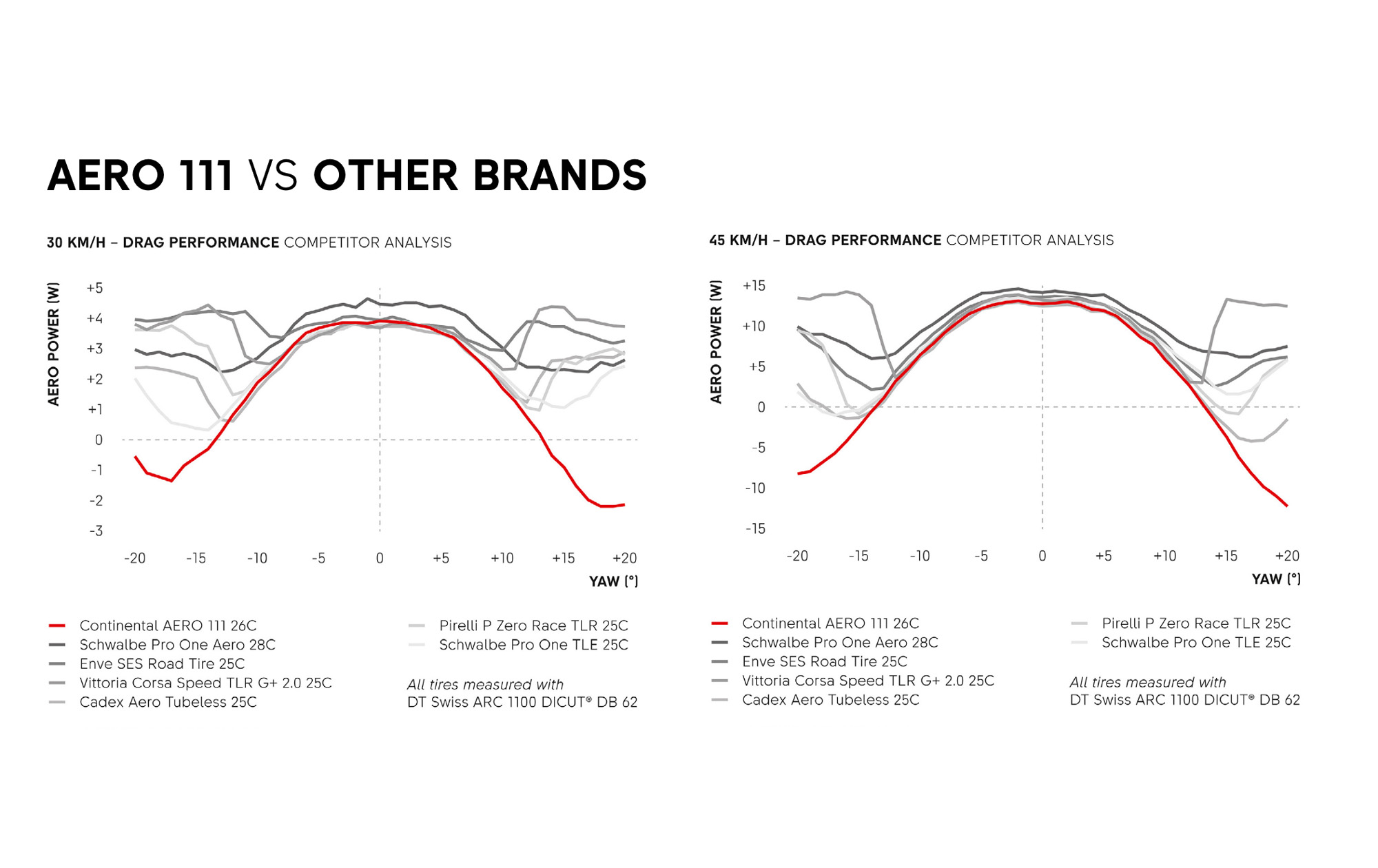
Finally: testing comparing the Aero 111 to other tyres from other manufacturers. The testing looked at a mix of tyres, some wider, some narrower, and from brands like Schwlabe, Pirelli, Enve, Vittoria and Cadex. Unfortunately, again we weren’t given raw numbers, and the other tyre lines are so similar in colour it's almost impossible to differentiate them. Further, the GP 5000s TR testing seen above has not been overlayed, which would have added a valuable point of comparison. All that said, the graph seems to indicate the Aero 111 (red line) is significantly faster at the outer ranges of the yaw sweep, but actually two other tyres may be a watt faster at the lower angle and speed combo of -5° to 0° and 30 km/h.
The scale changes for the higher 45 km/h speed, and the Aero 11 again seems to track closely with the other tyres from about -12° to + 10° or so, but then demonstrates a significant dropoff in drag, even negative drag as again the sail effect kicks in at the outer ranges of the yaw sweep. Again, I’m not sure if you’d be riding 45 km/h and experience -20° yaw continuously and so the aero speed difference may be a mute point, but again the aero and control benefits of the Aero 111 seem to be evident in the graph.
111 go, we all go
The Aero 111 tyre is one of those things that looks ludicrously simple, but actually probably took a heck of a lot of work to refine and create.
We have both 26 and 29 mm versions in for testing but have not yet ridden them (they arrived the day before I headed off to cover the Tour de France).
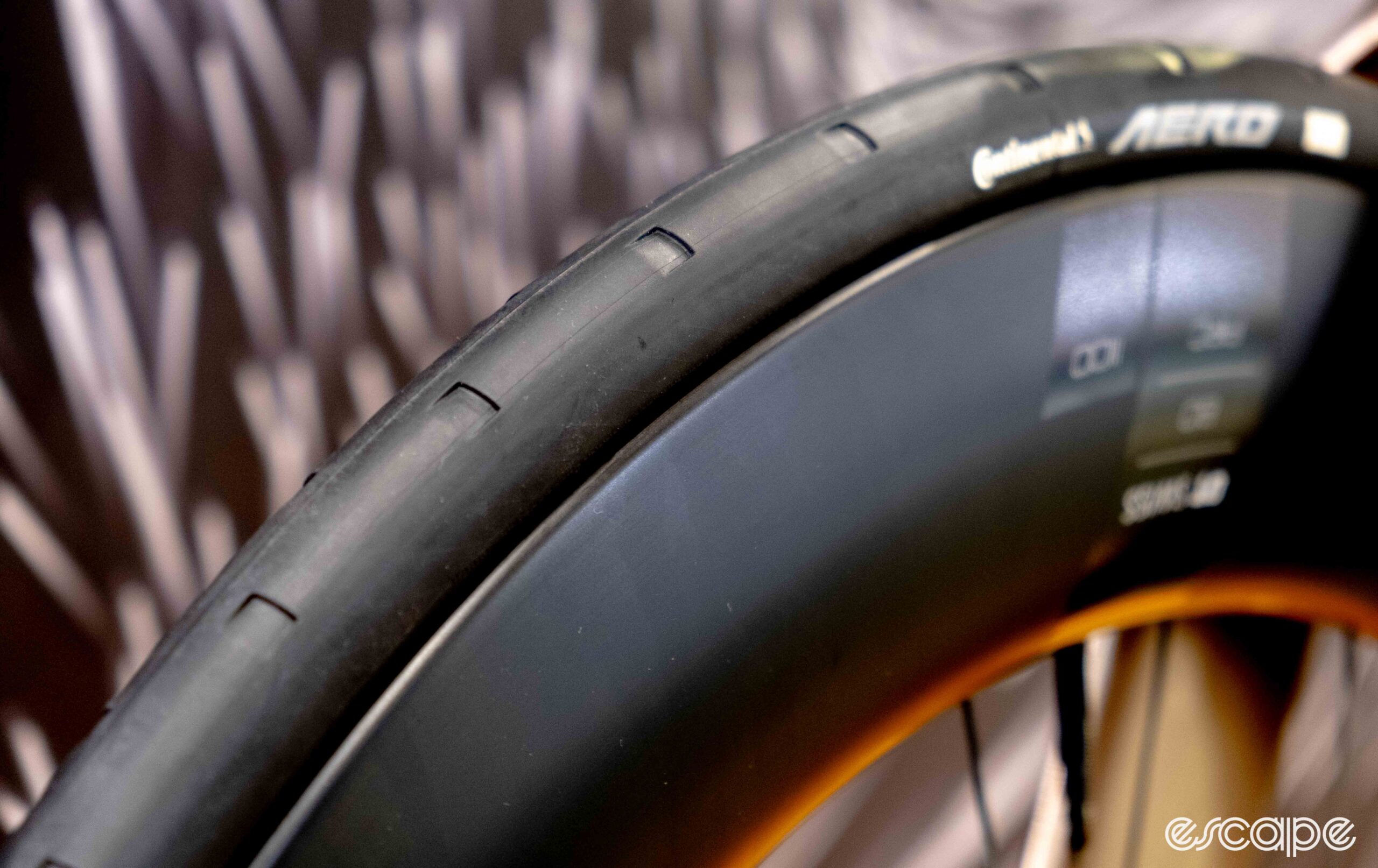
Having held the new tyres I can say the shoulder or transition from tread to sidewall is perfectly seamless, even moreso than that on the GP 5000s TR. The brands didn’t specifically mention this in the presentation on the new tyre, but I do wonder if this also aids in the tyre’s aero performance.
There are also a heck of a lot of other questions that only riding and testing will answer. Qeustions like: How does it perform in wet weather? Is it more or less puncture- and cut-resistant than the GP 5000s TR, which I have had great luck with but I have seen others cut and puncture on the very first ride?
Then there are questions we perhaps can’t answer. Questions like: How much of any aero gain is lost if the cutouts fill up with dirt or just wear down? And what is the wear rate? All the brands claim the wear rate is in line with other GP 5000 tyres and that testing they’ve conducted indicates the aero gain does not significantly diminish with tyre wear. They’ve also included a three-dot wear indicator in the tread to help keep track of wear; presumably once you are past all three the tyre is both worn and no longer aero.
Finally, there was one question JP Ballard of SwissSide could answer for me now: “Why is it front wheel-only; is there something we are giving up by opting for the Aero 111 and what if someone wants matching front and rear tyres.” Ballard’s answer was pretty simple. "It’s a cost consideration," he said. All the aero gains are at the front, and so adding what is a more expensive tyre to the rear doesn’t offer any additional gains. As such, the advice was save your money and run an S TR on the rear.
Whatever the answer to those questions, the DT Swiss, Continental and SwissSide trident may just have forked a new segment in the aero market. Until now all the wheel system aero development has been on the wheel itself. Any “aero tyres” until now have mostly been a happy accident or offset with terrible rolling resistance. The Aero 111 is the exact opposite of an accident; it was an intentional effort by several performance-focused companies to produce a tyre to be aero and fast. As with everything in cycling, if it’s a winner, expect to see countless others follow suit with a whole host of new takes on aero rubber and a whole new aero race.
Did we do a good job with this story?




